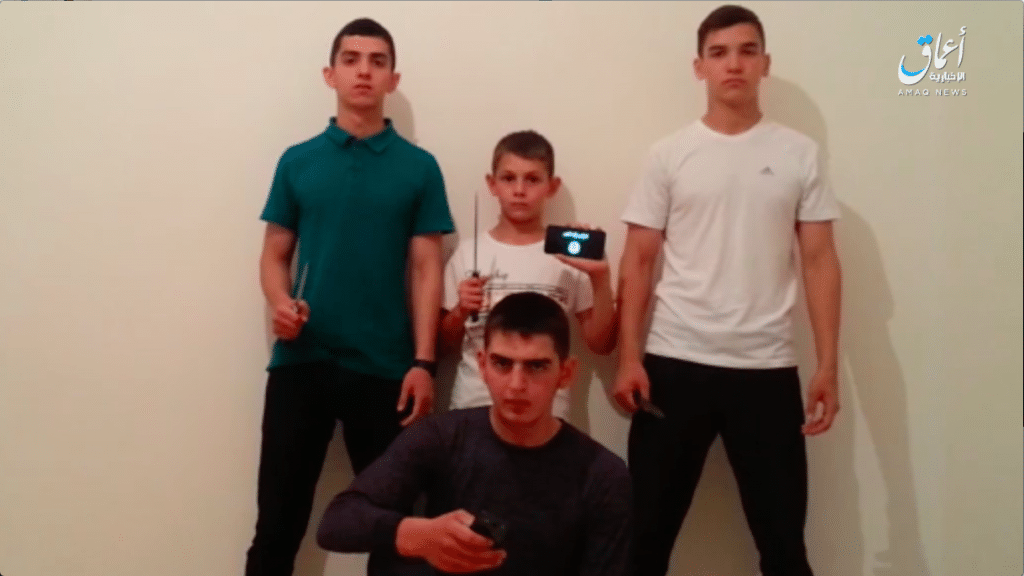June 24, 2019 | FDD's Long War Journal
Islamic State claims attack on Chechen leader’s home in Grozny
June 24, 2019 | FDD's Long War Journal
Islamic State claims attack on Chechen leader’s home in Grozny
An Islamic State loyalist was shot and killed yesterday outside the home of Chechnya’s leader, Ramzan Kadyrov, in the capital of Grozny. RT, a pro-Kremlin site, reported that the 23 year-old assailant wounded two officers, despite only using a knife. A hunting rifle was reportedly found in his car. RT also posted a video of the incident that was recorded at a distance. Gunfire can be heard at the scene as security forces close in.
Russian news sites say the man was stopped during a routine ID check. The Islamic State has portrayed the event as a somewhat more daring operation. The so-called caliphate first released a short statement claiming responsibility on behalf of its fighter.
The Islamic State’s Amaq News Agency then produced a one-page statement, describing the incident as an inghimasi attack targeting the Chechen president’s residence in Grozny. Inghimasis are generally well-trained fighters who immerse themselves in battle but are willing to become “martyrs” for the cause.
Amaq says the assailant was an Islamic State “fighter” known as Abdullah al-Shishani. He supposedly managed to kill and wound a number of Ramzan Kadyrov’s bodyguards with a machine gun. Amaq also claims that Abdullah fired at Kadyrov’s residence before he was killed in the clash.
The Islamic State’s account is at odds with that produced by Russian sites. For instance, whereas some Russian news sources say the attacker used only a knife, Amaq claims he used a “machine gun.”
As FDD’s Long War Journal has reported in the past, it is often difficult, if not impossible, to verify the details of events that occur inside Chechnya or elsewhere in Russia.
However, cells and individual terrorists loyal to the Islamic State have operated in and around Grozny for years. Some examples are included below.

In Dec. 2016, the Islamic State released footage of 11 young males vowing attacks in Grozny and swearing their fealty to Abu Bakr al-Baghdadi. They attacked police earlier that month.
On Dec. 17, 2016, a group of young men attacked police near Grozny, leading to several casualties. Chechen security forces launched counterterrorism raids the following day, killing or capturing multiple other alleged assailants. Chechen authorities identified the ringleader of the group as Said-Ibragim Ismailov. According to Radio Free Europe/Radio Liberty, law enforcement officials said Ismailov “had been in contact with what they called his commander in Syria via the Internet.”
Later that same month, on Dec. 28, the Islamic State released a video (“Now, Now the Fighting Comes”) showing a group of youths and young men vowing to strike in Grozny and elsewhere. The 11 Islamic State loyalists clasped hands as they pronounced their fealty to the “Amir-ul-Mumineen,” or Emir of the Faithful, Abu Bakr al-Baghdadi. A screen shot of the footage can be seen above.

In Mar. 2018, Amaq released a video showing this terrorist brandishing a knife, which he used to attack police in Grozny.
On Mar. 20, 2018, a lone assailant stabbed and slashed at police in Grozny. Shortly afterwards, Amaq News released a video of the Baghdadi loyalist brandishing a knife as he sat in front of a small Islamic State flag on the wall behind him. He addressed the “brothers” who are on “social networks” and implored them to lash out. He told fellow believers that they should kidnap or kill “all apostates” wherever they may live.
On May 19, 2018, a four terrorists stormed the Archangel Michael Church in Grozny. The assailants took hostages inside the church before they were killed by police. The Islamic State claimed responsibility for the attack in a statement released online the following day.
Three months later, on Aug. 20, a team of four young males assaulted police in Chechnya. One or two of the assailants used their vehicle, a Mercedes, to run over policemen in Grozny. Two others, armed with knives, assaulted police in the town of Shali. And at least one member of the terror team attempted to blow himself up at a police checkpoint in the village of Mesker-Yurt. Chechen authorities quickly blamed the Islamic State’s “special programs to brainwash teenagers” for the attacks.
On the following day, Aug. 21, the Islamic State released a short video of the youths swearing allegiance to Abu Bakr al-Baghdadi. A screen shot can be seen below.

In Aug. 2018, this group of four youths assaulted police in Grozny and Shali.
In April of this year, Russia’s security service, the FSB, said it captured five members of an “underground cell” loyal to the Islamic State in Makhachkala and Grozny. The cell’s members allegedly planned to attack police in Kaspiysk and Grozny using a small drone.
The FSB released a video of the cell’s purported ringleader. He explained that they intended to use a quadcopter in the assault.
“I was making preparations for making an armed attack against a traffic or police patrol. I made a plan and was going to purchase a quadcopter to equip it with a release mechanism, made in the Islamic State,” the detainee said, according to TASS, a Russian News Agency. “My intention was to use a makeshift bomb stuffed with shrapnel and attached to a quadcopter. I planned an attack from the air.”
The Islamic State has often used drones across Iraq and Syria, including during the battle for Mosul in 2017. The jihadists have attached explosives to small commercial drones, or drones they’ve manufactured in their own facilities. They then drop the explosives on their foes. [See FDD’s Long War Journal report: Islamic State uses improvised weapons of war in Mosul, Iraq.]
It appears, based on Russia’s reporting, that a cell in Grozny wanted to employ the same tactic earlier this year.
